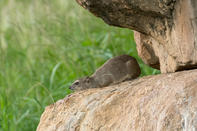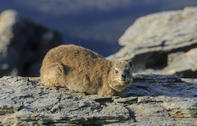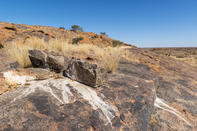Between a Rock and a Hard Place

Rock dassies are remarkable for the fact that they colonize an otherwise fairly inhospitable habitat – rocks. Rocks are cold when the temperature is low and are extremely hot and exposed when the sun is high.
Dassies are insulated from the cold by a double layer of fur. The fur closest to the skin is woolly and warm while the outer layer closes this in with a thicker, rougher layer or guard coat that protects and streamlines the animal.
Amongst its normal pelage all over the body are long tactile (touch-sensitive) hairs that may protrude by 7cm. These act like whiskers and help dassies to orientate themselves in the darkness of rock crevices. They also have 10 cm long whiskers on their faces to help with this.
The colour and stout, rounded body of a dassie is such that it is hard to distinguish it from the often stone-strewn nature of the rocky areas where it lives. This is a form of camouflage. Furthermore, dassies sit still for long periods of time either sunning themselves or resting. This helps their ‘concealment’ even further as predators will only recognize them as prey once they are seen moving.
Watch for Predators

Dassies take refuge from predators, cold and by night in crevices and holes in the rocks. By day they are seldom further away from such a refuge than 15 m and will take to it as soon as the alarm signals danger from the skies.
Black eagles are their primary predators. Usually, an older female plays the role of sentinel. Sometimes suitable hiding places are limited and it is thought that this is one of the reasons that dassies live in groups. Because dassies are always on the lookout for black eagles, they have highly modified eyes that are thought to allow them to look directly into the sun. A device in the eye known as the ‘umbraculum’ acts as a shield.
The pupil of a dassie’s eye is kidney-shaped. This is orientated horizontally with the concave edge on the top and may also have something to do with their unique vision capabilities. After a protracted gestation period young are born precocial (fully haired with their eyes open).
They are capable of agile movement within a day. It is essential that young spend a longer time within the safety of the womb so that they are born well developed and are immediately able to dodge danger. Helpless young would quite literally provide ‘sitting ducks’ to the dassies’ predators. In parts of southern Africa, dassies provide an essential source of meat and their skins are dried or made into karosses.
Water When Needed

Dassies drink when water is available but they have very efficient kidneys and can extract most of their moisture requirements from the food they eat. If they only have dry material on which to feed, they do rely on dew or succulent plants for moisture.
Dassies confine their excretions to latrines which may become exceptionally large and stained from protracted usage. Crystallized dassie urine is believed to possess medicinal properties and has been commercially supplied as “hyracium”.
By Megan Emmett